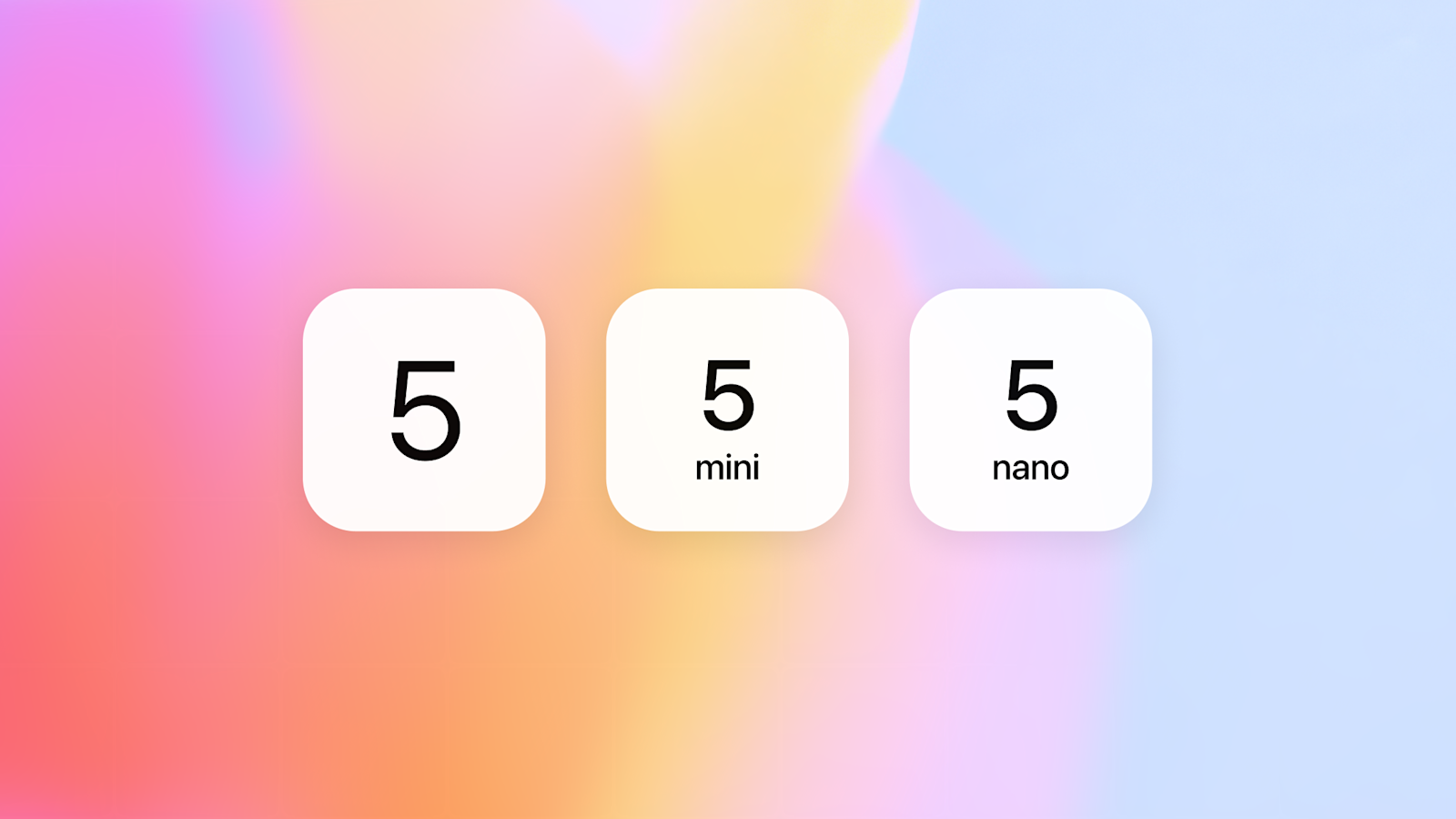
OpenAI Launches GPT-5 for Developers
Sources: https://openai.com/index/introducing-gpt-5-for-developers, openai.com
TL;DR
- OpenAI released GPT-5 in the API, featuring state-of-the-art coding and agentic capabilities.
- New developer controls include a verbosity setting, a minimal reasoning option, and a custom-tools interface for plaintext tool calls.
- Available in three API sizes (gpt-5, gpt-5-mini, gpt-5-nano) optimized for performance, cost, and latency.
Context and background
OpenAI announced GPT-5 for developers as the latest evolution in its API platform, positioning it as the best model to date for coding and agentic tasks. The model is described as state-of-the-art on key coding benchmarks and is the result of real-world coding work with early testers across startups and enterprises. In internal and external feedback, GPT-5 demonstrated strong performance in diverse scenarios—from writing and debugging code to reasoning over large codebases and driving long-running, multi-step workflows. The release underscores OpenAI’s ongoing effort to advance tool use, plan execution, and end-to-end task completion in real-world settings. OpenAI GPT‑5 announcement.
What’s new
GPT-5 introduces several developer-oriented enhancements designed to increase control, reliability, and end-to-end task execution. Key additions include:
- A new verbosity parameter with values: low, medium, high, to control whether answers are short or long and comprehensive.
- A new reasoning_effort parameter that can take a minimal value to return answers faster when less reasoning is acceptable.
- A new tool type—custom tools—that allows GPT-5 to call tools with plaintext instead of JSON, and to constrain tool usage with developer-supplied grammars.
- API availability in three sizes: gpt-5, gpt-5-mini, and gpt-5-nano, enabling developers to trade off performance, cost, and latency.
- A distinction between GPT‑5 in ChatGPT (system of reasoning, non-reasoning, and routing models) and GPT‑5 in the API (the reasoning model that powers maximum performance in ChatGPT). The non-reasoning ChatGPT model is available as gpt-5-chat-latest. OpenAI GPT‑5 announcement. In addition to these controls, GPT‑5 demonstrates improved tool intelligence, better handling of tool errors, and the ability to chain dozens of tool calls—sequentially or in parallel—without losing direction. Internal testers highlight its proactive approach to ambitious tasks and its capacity to provide updates between tool calls when producing longer outputs. As part of the broader platform, GPT‑5 is the strongest coding model OpenAI has released, outpacing prior models on multiple benchmarks and real-world use cases. OpenAI GPT‑5 announcement. A number of external evaluators have cited GPT‑5 as highly capable in frontend coding, code understanding, and large-scale reasoning. In internal testing, GPT‑5 was preferred over other models in frontend tasks about 70% of the time when tasked with creating aesthetically minded and accurate frontend code. The model also shows marked improvements in long-context retrieval and multi-step task execution, helping teams reason about their own codebases more effectively. OpenAI GPT‑5 announcement. To illustrate the breadth of GPT‑5’s capabilities, OpenAI shared examples of generating complex site content from a single prompt and then executing a plan that includes scaffolding, dependency installation, content creation, and a build check, with progress updates during the task. The example demonstrates how GPT‑5 can present a plan, execute it, and summarize its progress in real time. OpenAI GPT‑5 announcement.
Why it matters (impact for developers and enterprises)
GPT‑5 is designed to be a better coding collaborator and a more capable agent for long-running tasks. For developers, the model offers higher-quality code generation, improved debugging and code editing capabilities, and deeper understanding of complex codebases. It excels in agentic coding products like Cursor, Windsurf, GitHub Copilot, and Codex CLI, where planning, multi-step tool use, and reliability are critical. In internal benchmarks and external tests, GPT‑5 demonstrates state-of-the-art performance across multiple coding tasks, while using fewer output tokens and fewer tool calls than prior models at higher reasoning settings. This efficiency translates into faster iteration cycles, more reliable automation, and a smoother developer experience when building and maintaining software. OpenAI GPT‑5 announcement. For enterprises, GPT‑5’s robust tool use and long-context capabilities can accelerate product development, improve code maintainability, and support complex engineering workflows that span multiple tools and APIs. Early enterprise feedback highlights the model’s ability to chain many tool calls reliably and to retrieve long-context information efficiently, enabling sophisticated automations and end-to-end task execution in real-world environments. OpenAI GPT‑5 announcement. A few benchmark highlights help frame GPT‑5’s impact: | Benchmark | GPT‑5 score | Notes |---|---|---| | SWE-bench Verified | 74.9% | Up from 69.1% for o3; faster and with fewer tokens and tool calls |Aider polyglot | 88% | Record performance; one-third fewer errors than o3 |τ2-bench telecom | 96.7% | SOTA results for tool-calling benchmarks | These results underscore GPT‑5’s strength in both coding and long-running agentic tasks, including improved handling of tool errors and better alignment with developer instructions. OpenAI GPT‑5 announcement.
Technical details or Implementation (how it works in practice)
GPT‑5 is released in three API sizes to accommodate varying cost and latency constraints: gpt-5, gpt-5-mini, and gpt-5-nano. This tiered approach gives developers flexibility to dial in performance and price. The API version of GPT‑5 is described as the reasoning model that powers maximum performance in ChatGPT, while GPT‑5 in ChatGPT itself is a different system composition that includes reasoning, non-reasoning, and router components. The non-reasoning variant used in ChatGPT is accessible as gpt‑5-chat-latest. OpenAI GPT‑5 announcement. New developer controls are designed to be practical and expressive. The verbosity setting lets teams tailor answer length to their UI/UX needs, while the minimal reasoning option enables faster responses when deep reasoning is not required. The custom tools feature enables GPT‑5 to call tools using plaintext and introduces grammars to constrain tool usage, improving safety and predictability in automated workflows. In practice, these controls help maintain momentum on long-running tasks, with the model offering upfront explanations about its plan and progress between tool calls when appropriate. OpenAI GPT‑5 announcement. In field tests, GPT‑5 showed marked enhancements in front-end coding, producing more aesthetically minded and accurate results than previous models in direct comparisons. The model also demonstrated improved capability to reason about complex, multi-component codebases, including OpenAI’s reinforcement learning stack, where it can help teams understand how different parts of the system interoperate. [OpenAI GPT‑5 announcement](https://openai.com/index/ introducing-gpt-5-for-developers).
Key takeaways
- GPT‑5 is OpenAI’s strongest coding model to date and excels at agentic tasks and long-running workflows.
- It introduces new controls: verbosity, minimal reasoning, and custom tools with grammar constraints.
- Availability spans three API sizes (gpt-5, gpt-5-mini, gpt-5-nano) to balance performance, cost, and latency.
- GPT‑5 in the API is a dedicated reasoning model; ChatGPT uses a different combination of reasoning and routing components.
- Benchmark results indicate SOTA performance on SWE-bench Verified, Aider polyglot, τ2-bench telecom, and long-context retrieval tasks.
FAQ
-
What is GPT‑5 in the API designed to do?
It is the reasoning model that powers maximum performance in ChatGPT and is optimized for coding and agentic tasks, with improved tool use and planning capabilities. [OpenAI GPT‑5 announcement](https://openai.com/index/introducing-gpt-5-for-developers).
-
What new controls are available to developers?
A verbosity parameter (low, medium, high), a minimal reasoning value for faster answers, and a custom tools interface that supports plaintext tool calls with grammar-based constraints. [OpenAI GPT‑5 announcement](https://openai.com/index/introducing-gpt-5-for-developers).
-
How many API sizes are offered, and how do they differ?
Three sizes—gpt-5, gpt-5-mini, gpt-5-nano—designed to balance performance, cost, and latency for different use cases. [OpenAI GPT‑5 announcement](https://openai.com/index/introducing-gpt-5-for-developers).
-
How does GPT‑5 perform on coding benchmarks?
It scores 74.9% on SWE-bench Verified and 88% on Aider polyglot, with improvements in tool calling efficiency and reduced token usage relative to prior models. [OpenAI GPT‑5 announcement](https://openai.com/index/introducing-gpt-5-for-developers).
References
More news
First look at the Google Home app powered by Gemini
The Verge reports Google is updating the Google Home app to bring Gemini features, including an Ask Home search bar, a redesigned UI, and Gemini-driven controls for the home.
OpenAI reportedly developing smart speaker, glasses, voice recorder, and pin with Jony Ive
OpenAI is reportedly exploring a family of AI devices with Apple's former design chief Jony Ive, including a screen-free smart speaker, smart glasses, a voice recorder, and a wearable pin, with release targeted for late 2026 or early 2027. The Information cites sources with direct knowledge.
Shadow Leak shows how ChatGPT agents can exfiltrate Gmail data via prompt injection
Security researchers demonstrated a prompt-injection attack called Shadow Leak that leveraged ChatGPT’s Deep Research to covertly extract data from a Gmail inbox. OpenAI patched the flaw; the case highlights risks of agentic AI.
Predict Extreme Weather in Minutes Without a Supercomputer: Huge Ensembles (HENS)
NVIDIA and Berkeley Lab unveil Huge Ensembles (HENS), an open-source AI tool that forecasts low-likelihood, high-impact weather events using 27,000 years of data, with ready-to-run options.
Scaleway Joins Hugging Face Inference Providers for Serverless, Low-Latency Inference
Scaleway is now a supported Inference Provider on the Hugging Face Hub, enabling serverless inference directly on model pages with JS and Python SDKs. Access popular open-weight models and enjoy scalable, low-latency AI workflows.
How chatbots and their makers are enabling AI psychosis
Explores AI psychosis, teen safety, and legal concerns as chatbots proliferate, based on Kashmir Hill's reporting for The Verge.





